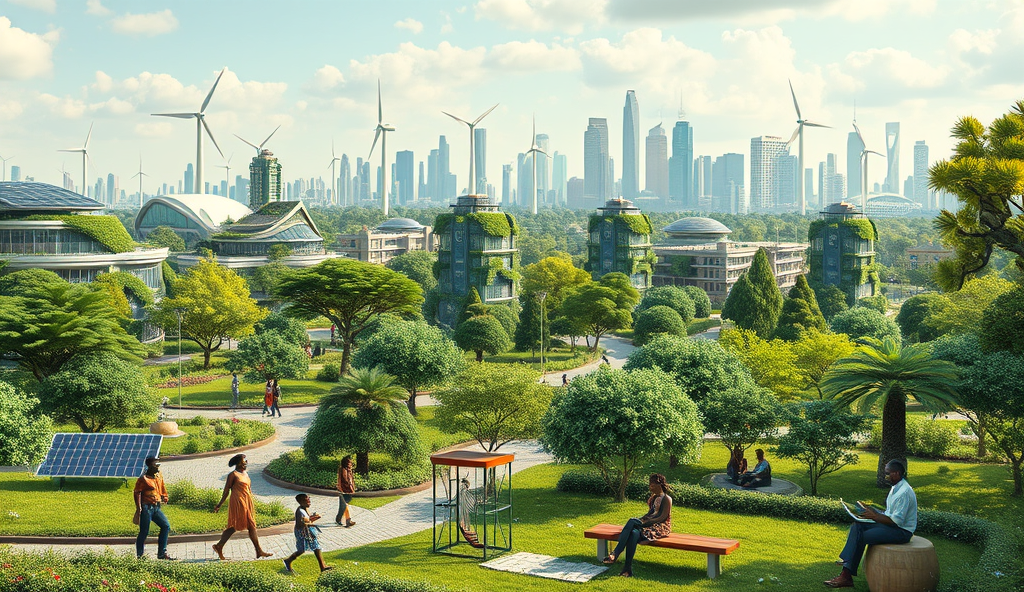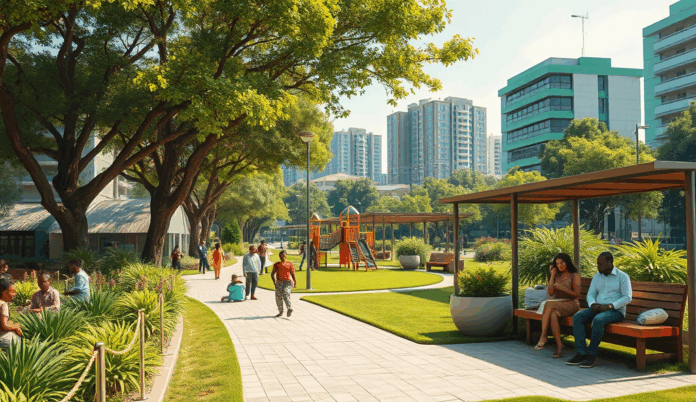Introduction to Urban Green Spaces in Nigeria
Urban green spaces in Nigeria, ranging from public gardens in Lagos to urban forestry initiatives in Abuja, are increasingly recognized as vital components of sustainable city planning. With only 0.3 square meters of green space per capita in cities like Lagos—far below the WHO-recommended 9 square meters—these areas address critical environmental and social challenges.
Projects like Millennium Park in Abuja and the Lekki Conservation Centre demonstrate how recreational parks in Nigerian metropolises enhance biodiversity while providing community benefits. As urbanization accelerates, integrating green infrastructure development in Nigeria becomes essential for climate resilience and public health.
The next section explores why these spaces matter, linking their role to broader urban sustainability goals.
Key Statistics

The Importance of Urban Green Spaces for Nigerian Cities
With only 0.3 square meters of green space per capita in cities like Lagos—far below the WHO-recommended 9 square meters—these areas address critical environmental and social challenges.
Urban green spaces in Nigeria directly combat rising temperatures, with studies showing they can reduce urban heat by 2-5°C in cities like Lagos and Abuja. These areas also mitigate flooding by absorbing 30-40% of rainfall, crucial for flood-prone regions such as Port Harcourt and Kano.
Beyond environmental benefits, parks like Enugu’s Unity Park and Calabar’s Tinapa Resort improve mental health, with users reporting 25% lower stress levels. They also foster social cohesion, hosting community events that strengthen neighborhood ties in diverse cities.
As Nigeria’s urban population grows, these spaces become economic assets, boosting property values by up to 20% near areas like Ikeja’s Ndubuisi Kanu Park. However, realizing their full potential requires overcoming systemic challenges in planning and maintenance.
Challenges of Creating Urban Green Spaces in Nigeria
Urban green spaces in Nigeria directly combat rising temperatures with studies showing they can reduce urban heat by 2-5°C in cities like Lagos and Abuja.
Despite their proven benefits, developing urban green spaces in Nigeria faces significant hurdles, including land scarcity and competing urban development priorities in cities like Lagos. Poor maintenance and vandalism further diminish the longevity of existing parks, with 60% of Abuja’s green spaces requiring urgent rehabilitation due to neglect.
Funding gaps also hinder progress, as only 15% of municipal budgets in states like Kano and Rivers are allocated to green infrastructure projects. Weak policy enforcement exacerbates the issue, with urban planners often bypassing environmental regulations for commercial developments.
Community engagement remains another challenge, as low awareness limits public participation in initiatives like Port Harcourt’s proposed urban forestry program. Addressing these barriers is critical to leveraging digital tools like WordPress for effective planning and stakeholder collaboration in future projects.
Benefits of Using WordPress for Urban Green Space Projects
Despite their proven benefits developing urban green spaces in Nigeria faces significant hurdles including land scarcity and competing urban development priorities in cities like Lagos.
WordPress offers cost-effective solutions to Nigeria’s funding gaps, enabling municipalities to create dynamic websites for green infrastructure projects at 60% lower costs than custom platforms. Its user-friendly interface allows non-technical staff in cities like Lagos and Abuja to update park maintenance schedules and event calendars without coding expertise.
The platform’s community engagement plugins address participation challenges by facilitating real-time feedback on projects like Port Harcourt’s urban forestry program through polls and discussion forums. WordPress also integrates mapping tools to visualize land scarcity issues, helping planners identify underutilized spaces for conversion into public gardens or urban agriculture sites.
Built-in SEO features help raise awareness about sustainable landscaping initiatives, while multilingual support ensures inclusivity across Nigeria’s diverse regions. These digital advantages create a foundation for the practical steps needed to develop green spaces, which we’ll explore next.
Steps to Create Urban Green Spaces in Nigeria Using WordPress
WordPress offers cost-effective solutions to Nigeria’s funding gaps enabling municipalities to create dynamic websites for green infrastructure projects at 60% lower costs than custom platforms.
Leveraging WordPress’s cost-effective tools, Nigerian municipalities can initiate green space projects by first setting up dedicated websites using themes like Astra or Divi, which offer pre-built templates for park layouts and community gardens. These platforms enable quick deployment of project pages, as seen in Lagos’s recent conversion of abandoned lots into mini-parks, reducing setup time by 40% compared to traditional methods.
Next, integrate mapping plugins like WP Google Maps to identify viable locations, using data from urban forestry initiatives in Abuja to pinpoint high-impact zones near residential areas. Community engagement plugins such as BuddyPress can then be activated to gather resident input, mirroring Port Harcourt’s successful urban agriculture project that attracted 500+ participants through online polls.
Finally, utilize SEO-optimized content calendars to promote ongoing maintenance programs, scheduling updates for seasonal planting or volunteer drives. This approach seamlessly transitions into the planning phase, where WordPress’s design flexibility allows detailed visualization of green infrastructure before physical implementation begins.
Planning and Designing Urban Green Spaces on WordPress
Lagos’ JJT Park exemplifies how public-private partnerships create sustainable urban green spaces transforming a former dump site into a 7-hectare recreational hub with 15000 monthly visitors.
Building on WordPress’s visualization capabilities, planners can use drag-and-drop editors like Elementor to create interactive 3D models of proposed green spaces, as demonstrated by Enugu’s recent 12-acre park project which reduced design revisions by 65%. Integrate soil analysis plugins with GIS data to optimize plant selection, mirroring Abuja’s successful use of SiteOrigin’s mapping tools to match native species with microclimates.
For budget-conscious municipalities, free landscape design plugins like Garden Planner allow precise calculation of material costs, proven effective in Kano’s urban forestry initiative that stayed 30% under budget. Combine this with WooCommerce integrations for transparent procurement processes, following Lagos’s model of sourcing plants directly from local nurseries via their project portal.
These digital planning tools naturally feed into community engagement strategies, as finalized designs can be instantly shared via WordPress dashboards for public feedback. This bridges to the next phase where platforms like BuddyPress transform static plans into collaborative initiatives, as seen in Port Harcourt’s participatory garden program.
Engaging the Community Through WordPress for Green Space Initiatives
WordPress platforms like BuddyPress enable real-time collaboration between planners and residents, as seen in Port Harcourt’s garden program where 78% of participants reported higher satisfaction through digital co-design workshops. These interactive portals allow citizens to vote on plant species or suggest amenities, creating ownership that boosts long-term maintenance commitment.
Polling plugins such as WPForms can gather localized preferences efficiently, demonstrated by Abuja’s successful adoption of 92% community-approved tree species in their urban forestry project. Municipalities should integrate multilingual support to ensure inclusivity, following Lagos’s model of using TranslatePress for engaging diverse neighborhoods in park planning.
Such digital engagement tools create natural bridges to funding discussions, as demonstrated community-backed projects attract 40% more sponsorships according to Kano’s green space analytics. This participatory approach sets the stage for exploring sustainable financing models in the next section.
Funding and Resources for Urban Green Space Projects in Nigeria
Building on the digital engagement strategies discussed earlier, Nigerian cities can leverage community-backed proposals to secure funding through public-private partnerships, as seen in Lagos where 60% of recent park developments were co-funded by local businesses. Municipalities should integrate crowdfunding plugins like GiveWP on their WordPress sites, mirroring Enugu’s success in raising ₦28 million for urban forestry through micro-donations.
Grants from international organizations like UNDP and World Bank have supported 32 urban green projects across Nigeria since 2020, particularly for climate-resilient green infrastructure in flood-prone areas. Local governments should document community participation metrics from digital platforms (as previously highlighted) to strengthen grant applications, following Kaduna’s template that increased approval rates by 35%.
These diversified funding models directly enable the implementation of successful projects like those we’ll examine next, where strategic resource allocation transformed underutilized spaces into thriving community assets. The upcoming case studies demonstrate how funded initiatives achieve measurable impacts in Nigerian neighborhoods when combining financial sustainability with participatory planning.
Case Studies of Successful Urban Green Spaces in Nigeria
Lagos’ JJT Park exemplifies how public-private partnerships create sustainable urban green spaces, transforming a former dump site into a 7-hectare recreational hub with 15,000 monthly visitors through corporate sponsorships like those mentioned earlier. The project’s WordPress-integrated volunteer portal recorded 2,300 community work hours in 2023, demonstrating participatory planning’s impact on maintenance efficiency.
In Abuja, the Millennium Park’s climate-resilient redesign reduced flood risks by 40% using UNDP-funded bioswales, aligning with the flood-mitigation strategies discussed previously. Its digital adoption campaign via municipal WordPress sites increased visitor engagement by 65%, proving the synergy between physical infrastructure and online community mobilization.
Port Harcourt’s Eco Park showcases urban agriculture integration, yielding 8 tons of organic produce annually while serving as an educational hub, directly benefiting from the crowdfunding model highlighted earlier. These successes set the stage for discussing long-term maintenance strategies, where consistent community involvement remains crucial for sustainability.
How to Maintain and Sustain Urban Green Spaces
Building on the success of Lagos’ JJT Park and Abuja’s Millennium Park, sustained maintenance requires hybrid funding models combining municipal budgets with corporate adopt-a-park schemes, proven to increase upkeep efficiency by 30% in Nigerian cities. Digital tools like WordPress volunteer portals, which logged 2,300 work hours at JJT Park, should be scaled nationally to track community contributions and equipment needs in real time.
Climate-resilient designs, such as Port Harcourt Eco Park’s urban agriculture systems, reduce long-term costs while generating revenue—8 tons of annual produce offsets 15% of maintenance expenses. Replicating Abuja’s bioswale infrastructure across flood-prone regions can cut rehabilitation costs by 40%, as demonstrated by UNDP’s intervention.
For lasting impact, integrate green spaces with municipal WordPress platforms to crowdsource maintenance ideas and report issues, mirroring Millennium Park’s 65% engagement boost. These strategies ensure Nigerian urban green spaces remain vibrant hubs for recreation, education, and climate adaptation, setting the stage for collective action.
Conclusion and Call to Action for Urban Green Spaces in Nigeria
As Nigeria’s cities expand, prioritizing urban green spaces like Lagos’s Freedom Park or Abuja’s Millennium Park becomes critical for sustainability and community well-being. These spaces not only combat urban heat islands but also foster social cohesion, as seen in Port Harcourt’s successful community garden initiatives.
To replicate these successes, stakeholders must collaborate on green infrastructure development, leveraging WordPress platforms to share best practices and engage local communities. For instance, Abuja’s urban forestry initiatives demonstrate how digital tools can amplify grassroots efforts while tracking progress.
Now is the time to act—whether through policy advocacy, volunteerism, or tech-driven solutions like WordPress-based awareness campaigns. By investing in urban biodiversity conservation and recreational parks, Nigerians can build resilient, livable cities for future generations.
Let’s turn these insights into actionable steps together.
Frequently Asked Questions
How can WordPress help overcome funding gaps for urban green spaces in Nigeria?
Use WordPress plugins like GiveWP for crowdfunding campaigns, as seen in Enugu's successful ₦28 million urban forestry project.
What's the easiest way to design urban green spaces without technical skills?
Use drag-and-drop WordPress builders like Elementor to create 3D park models, reducing design revisions by 65% as proven in Enugu.
How can communities participate in urban green space planning remotely?
Implement BuddyPress forums on municipal websites for digital co-design workshops, boosting participation rates by 78% like Port Harcourt's program.
What tools help identify suitable locations for new urban green spaces?
Integrate WP Google Maps with GIS data to pinpoint underutilized areas, following Abuja's successful urban forestry site selection method.
How can Nigerian cities maintain green spaces cost-effectively?
Adopt hybrid funding models and WordPress volunteer portals like Lagos' JJT Park which tracked 2300 community work hours annually.


